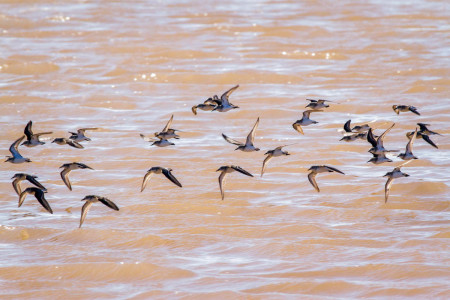
The sandpiper flocks fly up in waves, blurred wings beating and gliding as one, they circle around after being flushed and land again in unison on the dike road ahead of us while another flock lands just behind us. “Ok, start counting!” I say to my colleague, Fernando Simal. Easier said than done! The little brown birds dart about constantly on land and at the water’s edge, deftly snapping brine flies off the ground. We do our best to count the number of birds of each species using tally counters and record the numbers on our data sheet. This particular flock was composed mostly of Least Sandpipers and Semipalmated Sandpipers with a few Sanderlings thrown in.
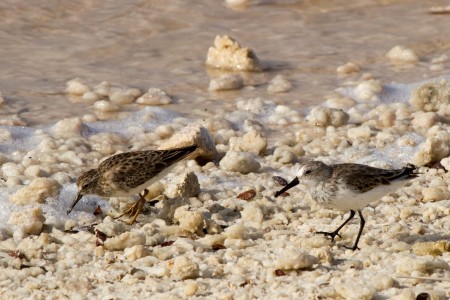
Fernando and I are at our one of our “high density” points (counting stations) on the Cargill Salt Production Facility in southern Bonaire. We are driving the dike roads stopping every 400m to carry out a 6-minute count, recording all the birds in a 200m radius around our point. A second team, Jeff Gerbracht (Cornell Lab of Ornithology) and Binkie van Es (St. Maarten Nature Foundation) are covering another part of the facility. The conditions can only be described as harsh—non-stop winds of 25-30 knots, blazing sun and salt foam blowing at us constantly. But the shorebirds love it, and so do we—there are not very many places where you can see such large concentrations and diversity of shorebirds so close.
We have so far encountered over 20 species of shorebirds and waterbirds using the Cargill ponds, including American Flamingo, Great Blue Heron, Tricolored Heron, Reddish Egret, Black-bellied Plover, Snowy Plover, Greater yellowlegs, Lesser Yellowlegs, Ruddy Turnstone, Stilt Sandpiper, Least Sandpiper, Semipalmated Sandpiper, Western Sandpiper, Short-billed Dowitcher, Red Knot and more. Depending on where the point is in the Cargill Facility, we might encounter zero birds in areas of deeper water, or mixed flocks numbering in the hundreds or even thousands in areas with shallow water or exposed flats.
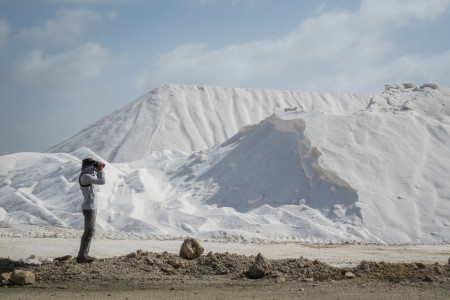
The prime attraction to this habitat is food—some of the ponds team with brine shrimp or brine fly larvae and the dike roads separating crystallizer ponds are often covered with hordes of brine flies. These small organisms, adapted to thrive in extremely salty conditions, serve as an essential food resource for these wintering and migratory shorebirds.
This is the second year of intensive surveys conducted at Cargill in an effort to learn more about the species and numbers of birds using this site. Shorebirds have received much attention in recent years due to evidence of alarming hemispheric-wide declines in numbers. Loss of wetland habitats is one of the main threats, but other factors also play a role, such as hunting, human disturbance, impacts from climate change such as sea level rise, and predation from invasive species.
In the case of the Red Knot, a threatened shorebird, numbers plunged from 90,000 to 15,000 from overharvesting of Horseshoe Crabs in the Delaware Bay in the early 2000s. The Bay is a critical migration staging area in spring where as much as 90% of the Red Knot population congregates to feast on horseshoe crab eggs. These birds rely on the eggs as a vital food source at their final stopover to build up enough fat and energy to make it back to their breeding grounds in the Arctic. They arrive in Delaware Bay in mid-May weighing about 120 grams, and depart 2 weeks later weighing 180 grams or more, with one particularly large individual weighing in at 244 grams at departure!
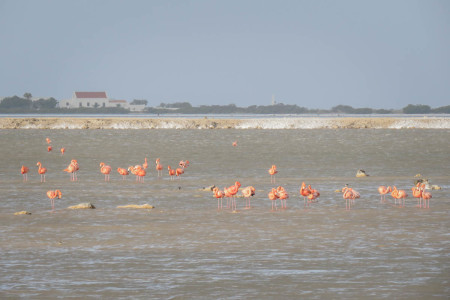
How and why did these surveys get started? Two years ago, I had the chance to visit and tour the Cargill Salt Production Facility for the first time, thanks to Daniel Deanda (Production Manager), who attended our Wetlands Education Training Workshop in May 2014, hosted by STINAPA Bonaire. I was amazed at the number of migratory shorebirds and waterbirds on the property, including the stunningly beautiful American Flamingos which dot the stark landscape like pink flowers. I recognized that this small island and even smaller site was probably hugely important to migrant and wintering shorebirds, perhaps even qualifying as a Western Hemisphere Shorebird Reserve Network (WHSRN) site, a program set up by Manomet 30 years ago to protect the most important breeding, stopover, and wintering habitats for shorebirds throughout the Americas.
Thanks to funding support from Environment Canada, the blessing of Cargill managers, and partnerships with local organizations STINAPA Bonaire, WILDCONSCIENCE, and the Dutch Conservation Nature Alliance, our surveys are providing estimates of population numbers of target species at the site. Although we are still refining our population estimates, there is no doubt that this site provides a winter home for thousands of shorebirds, enough to nominate it for a WHSRN site. It could also be a critical stopover area during spring and fall migration for shorebirds that are spending the winter further south. Additional counts planned for spring and fall of 2016 will help answer that question.
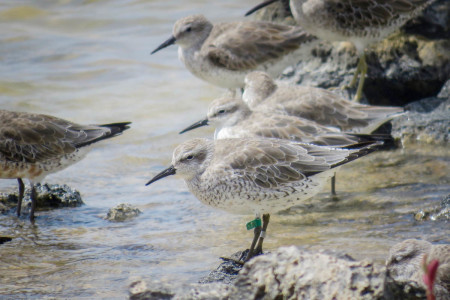
One of the most exciting finds from our 2016 February surveys were fairly large flocks of Red Knots. We noticed a leg band (green flag) on one of the birds and were able to read the flag—CTK. After entering the banding data into BandedBirds.org and corresponding further with the ornithologist that had banded the bird, Dr. Larry Niles, I learned that this bird was first captured and banded in 2004, making it a very old bird, at least 12 years of age. It was recaptured again in 2008 and May of 2015 in Delaware Bay. Larry commented: “On May 30 which is the end of this stopover period, the bird weighed only 154 g which is 26 grams short of the 180 g threshold necessary for a successful flight to the Arctic. Nevertheless this bird survived and still breeds.”
We think it is really cool that the salt ponds of Bonaire are providing a home for this Red Knot for the winter of 2015-2016, and perhaps other years as well! WHSRN site designation will help to raise awareness about the importance of “this little island” and the Cargill Salt Facility as a haven for migratory shorebirds.
by Lisa Sorenson, Ph.D. Executive Director, BirdsCaribbean
